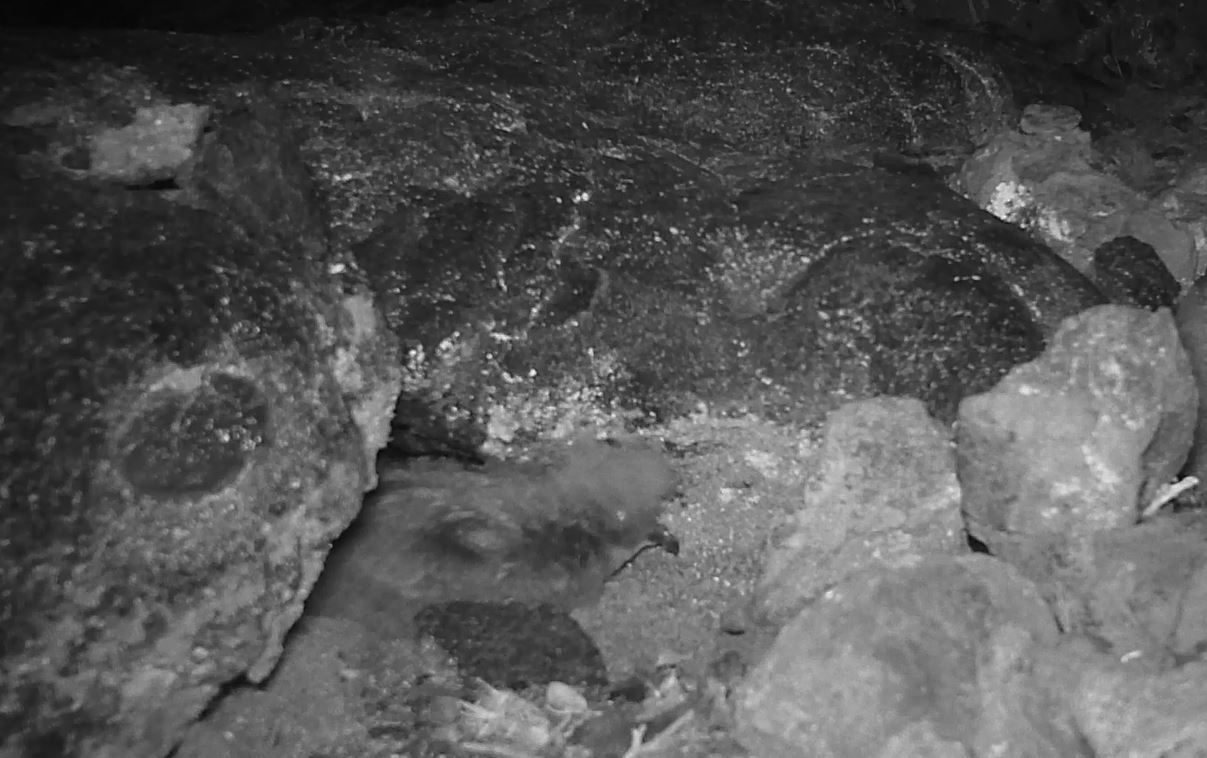News Release

NPS Photo from wildlife camera
|
Subscribe
|
Contact: Jessica Ferracane, 808-985-6018
HAWAII NATIONAL PARK, Hawaiʻi – New footage of a young ʻakēʻakē, an endangered nocturnal seabird, shows the fluffy fledgling emerging from its high-elevation burrow on Mauna Loa about a month before the eruption began, an exciting first for Hawaiʻi Volcanoes National Park.The ʻakēʻakē burrow was detected in the park by a really good boy named Slater of Hawaiʻi Detector Dogs, under the guidance of trainer and handler Dr. Michelle Reynolds. This is the first confirmed ʻakēʻakē nest identified in Hawaiʻi Volcanoes National Park, according to Biologist Charlotte Forbes Perry, who observed the chick inside its burrow after Slater sniffed it out in September – weeks before it emerged.
“Biologists in the park have known of the presence of ʻakēʻakē on Mauna Loa since the 1990s. In 2019, ʻakēʻakē burrow calls were recorded during acoustic monitoring which indicated nesting. The lack of visual signs like guano at their nest sites make them extremely hard for humans to locate,” Forbes Perry said. “We worked with Hawai’i Detector Dogs, and in two days, Slater located an ʻakēʻakē nest and three Hawaiian petrel nests,” she said.
Forbes Perry, a biologist with the University of Hawaiʻi Pacific Cooperative Studies Unit, and her team study seabirds in Hawaiʻi Volcanoes National Park under a permit from the U.S. Fish & Wildlife Service, an active partner on the project. After Slater discovered the nests, wildlife cameras were installed to monitor the burrows.
‘Akēʻakē, also known as the band-rumped storm petrel (Oceanodroma castro), are small (adults weigh about as much as a golf ball) and are ash black with a wide white band on their squarish tail, according to the American Bird Conservancy. They nest on isolated islands but spend the rest of their lives at sea. The global population is estimated to be about 150,000 individuals, with about 240 pairs known in Hawaiʻi.
Threats in Hawaiʻi include predation by non-native barn owls, cats and mongoose, and disorientation from artificial lights. Like ʻuaʻu (Hawaiian petrels), and other seabirds, ʻakēʻakē fly to their breeding sites in darkness.
Slater and trainer/handler Reynolds were also part of the team that discovered a new ʻakēʻakē burrow at the U.S. Army Garrison Pōhakuloa Training Area (PTA) in early September. The nests at PTA and Hawaiʻi Volcanoes National Park are the only documented ʻakēʻakē nests in Hawaiʻi.
The ʻakēʻakē and ʻuaʻu burrows are protected within the park’s 644-acre cat-proof fence and are not threatened by the current eruption of Mauna Loa volcano. People can help ensure the safety of seabirds by controlling their pets, especially cats, and using dark-sky friendly lighting. Bright urban lights disorient seabirds like ʻakēʻakē and ʻuaʻu.
While many are transfixed by the eruption that began on November 27, Forbes Perry and other conservationists are equally excited by the discovery of the ʻakēʻakē nest. “We are ecstatic by these finds, and detector dogs are an invaluable resource to help locate these elusive birds,” she said.
-NPS-
Last updated: December 7, 2022
